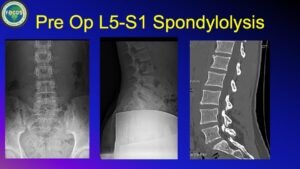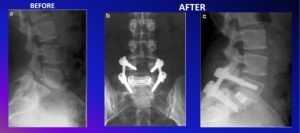Overview
Terminology: Spondylo (Spine) Lysis (Break) Listhesis (Slip)
This condition is commonly present in about 5% of the population and may be asymptomatic
- Dysplastic is usually a congenital abnormally of the facets and posterior elements.
- Isthmic (pars) is the bony zone between the facet joints a region subject to break.
- lytic (stress fracture),
- elongated (repetitive micro-fractures with /healing
- acute fracture (single event)
Activity-related with onset of low back pain., usually around the L5-S1. Typical in persons with a history of trauma – commonly among gymnasts, linemen, wrestlers.

- Slip more than 50%, adolescent growth spurt, in females
- Lysis: females less than males (2:1), listhesis females greater than males (4:1)
- Radiculopathy is pain radiating to the lower extremities
- Lysis may lead to scar tissues formation
- Dysplastic – with stretch on affected nerve roots by the intact arch
- Isthmic – narrowing of the nerve root canal (foraminal stenosis)
Clinical Exam
- Lumbar hyperlordosis/ flat buttocks
- Tight hamstring
- Crouched gait/ tilted pelvis
Imaging
- Plain X-rays in the standing position with oblique side view
- CT– best for bony pathology; localize lesion; confirm diagnosis; plan surgery
- MRI –
- Neuro deficit or unusual presentation
- Adjacent level hydration status
- SPECT or bone scan with increased uptake may indicate the potential of the break to heal in children.
Surgical Options
- Pars Repair: Good for spondylolysis with low grade slip in children
- Fusion in Situ: High fusion rate for single level L5-S1 and low grade with or without instrumentation
- Posterior Fusion with interbody Fusion (TLIF/PLIF)
- The type of surgery should be tailored to patient symptoms, Degree of slippage and neurologic status

The Role of instrumentation
- Higher fusion/complication rates
Anterior Fusion will increase arthrodesis rate
- High grade slips have a high incidence of neurologic complication if reduction is attempted. The slip angle reduction is more relevant than percent slip reduction for a good functional outcome.




